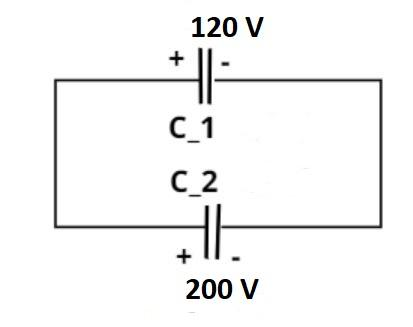
Two capacitors having capacitance
Answer
513.6k+ views
Hint: In this question use the relationship between the capacitance, charge and potential on a capacitor that is
Complete step-by-step solution:

As we know that the charge stored on the capacitor is the product of individual capacitance and the voltage stored in the capacitor.
Where, Q = charge, C = capacitance and V = voltage.
Now let the capacitance of first capacitor be
Charged voltages of the first and second capacitor are 120V and 200V.
So the charges on the first and second capacitor are
And
Now it is given that they are connected in parallel and it is found that the potential on each of them is zero.
So from equation (1) if the potential or voltage on each of them is zero then the charge on each of them will be zero.
It is only possible when they connected in phase opposition (i.e. positive sign connected to positive and negative sign connected to negative) as shown in figure, such that
Now substitute the values in above equation we have,
Now simplify this we have,
Divide by 40 throughout we have,
So this is the required relation between
Hence option (C) is the correct answer.
Note – The parallel combinatory of the capacitors is exactly equivalent to that series connection of the resistors that is
Complete step-by-step solution:

As we know that the charge stored on the capacitor is the product of individual capacitance and the voltage stored in the capacitor.
Where, Q = charge, C = capacitance and V = voltage.
Now let the capacitance of first capacitor be
Charged voltages of the first and second capacitor are 120V and 200V.
So the charges on the first and second capacitor are
And
Now it is given that they are connected in parallel and it is found that the potential on each of them is zero.
So from equation (1) if the potential or voltage on each of them is zero then the charge on each of them will be zero.
It is only possible when they connected in phase opposition (i.e. positive sign connected to positive and negative sign connected to negative) as shown in figure, such that
Now substitute the values in above equation we have,
Now simplify this we have,
Divide by 40 throughout we have,
So this is the required relation between
Hence option (C) is the correct answer.
Note – The parallel combinatory of the capacitors is exactly equivalent to that series connection of the resistors that is
Recently Updated Pages
Master Class 4 Maths: Engaging Questions & Answers for Success

Master Class 4 English: Engaging Questions & Answers for Success

Master Class 4 Science: Engaging Questions & Answers for Success

Class 4 Question and Answer - Your Ultimate Solutions Guide

Master Class 11 Economics: Engaging Questions & Answers for Success

Master Class 11 Business Studies: Engaging Questions & Answers for Success

Trending doubts
Give 10 examples of unisexual and bisexual flowers

Draw a labelled sketch of the human eye class 12 physics CBSE

a Tabulate the differences in the characteristics of class 12 chemistry CBSE

Differentiate between homogeneous and heterogeneous class 12 chemistry CBSE

Why is the cell called the structural and functional class 12 biology CBSE

Differentiate between insitu conservation and exsitu class 12 biology CBSE




